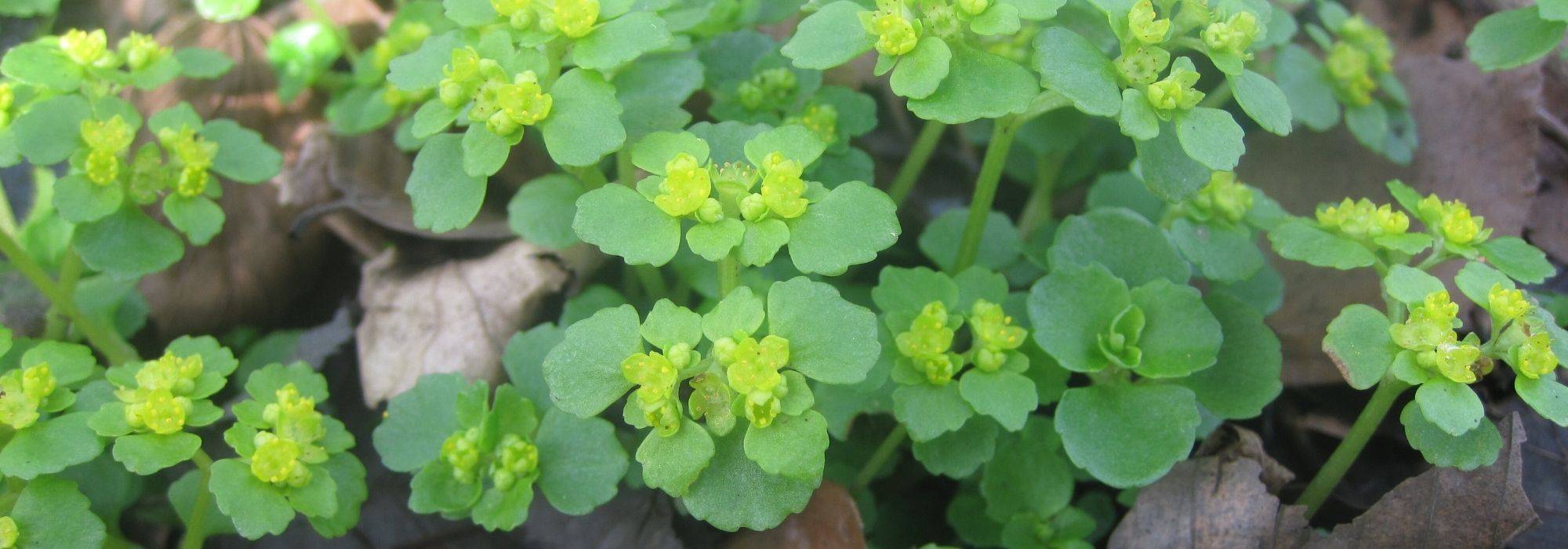
Chrysosplenium or golden Saxifrage : Planting, growing, and care
Contents
Chrysosplenium in a few words
- It is an excellent and original ground cover for damp and shaded areas
- It forms clumps of small, round, evergreen leaves adorned with pretty yellow or white-pink flowering in spring
- It prefers deep shade to full sun
- Easy to grow, very hardy, and low-maintenance, it thrives in humus-bearing, moist soil
- It is perfect for planting near a pond or in a damp woodland setting
The word from our expert
The Chrysosplenium or Golden Saxifrage is a small perennial that forms an original and luminous evergreen ground cover in damp soils and shaded areas of the garden. It thrives in partial shade, cool soils, and near water sources, where it quickly forms small clumps of rounded, fresh green leaves that remain decorative even in winter. Like the Chrysosplenium alternifolium (Alternate-leaved Golden Saxifrage), C. macrophyllum, or the Chrysosplenium oppositifolium (Opposite-leaved Golden Saxifrage), this dense cushion is adorned in spring with a yellow aniseed or pinkish-white flowering, perfect for adding a splash of colour to damp garden areas, by a pond, in a cool rockery, or in a fresh woodland setting.
Non-invasive and very hardy, it is easy to grow in cool soil and in a sheltered spot away from direct sunlight.
Discover this rhizomatous and evergreen perennial plant, perfectly suited to shady and damp environments!
Description and Botany
Botanical data
- Latin name Chrysosplenium
- Family Saxifragaceae
- Common name Golden saxifrage, rock cress, golden cress
- Flowering April-June
- Height 0 to 0.30 m
- Exposure Partial shade, shade
- Soil type Clay-limestone or humus-bearing, moist
- Hardiness -25°C
The Chrysosplenium, also known as Golden Saxifrage, is a small perennial plant belonging to the Saxifragaceae family, much like the Bergenia. There are approximately 65 species distributed across Asia (notably China), the Americas, Africa, and Europe. These plants naturally thrive in forest undergrowth, along small streams like Chrysosplenium oppositifolium, in rocky habitats, and in mountainous regions up to 1900 metres in altitude, such as Chrysosplenium macrophyllum, always in damp, more or less waterlogged and shaded areas. In France, except in the south, the Chrysosplenium alternifolium (Alternate-leaved Golden Saxifrage or Rock Golden Cress) is a protected species found in the wild. In our gardens, the most commonly encountered species are:
- Chrysosplenium alternifolium
- Chrysosplenium davidianum
- Chrysosplenium macrophyllum
- Chrysosplenium oppositifolium
This creeping, herbaceous perennial plant develops from a stoloniferous stump. Chrysosplenium quickly forms mats of leaves, 5 to 30 cm in height, spreading 30-50 cm wide via short, barely buried rhizomes. The plant roots itself sporadically, much like strawberries, using thread-like stolons. Eventually, it forms a low rosette of evergreen leaves, decorative even in winter.
The stems, often quadrangular, bear small ovate or rounded leaves measuring about 5 mm to 3 cm in diameter, with strongly crenate edges. They are alternate in the Alternate-leaved Golden Saxifrage or Chrysosplenium davidianum. They are either villous or glossy, with a lamina ranging from light green to chartreuse. Depending on the species, they may take on brown, purple, or golden hues.
In spring, from March-April to June depending on the climate, small yellow or anise-yellow flowers dot this sea of tiny leaves. They appear as flat, very bright inflorescences. The Chrysosplenium macrophyllum, or Large-leaved Golden Saxifrage, blooms from December-January to March with clusters of pinkish-white bell-shaped flowers. This Chinese species, with its large pubescent leaves, resembles a Bergenia.
The leaves of Chrysosplenium oppositifolium have depurative, diuretic, and expectorant properties and are sometimes eaten in salads.

Several species: Chrysosplenium alternifolium, Chrysosplenium davidianum and Chrysosplenium macrophyllum
Main species
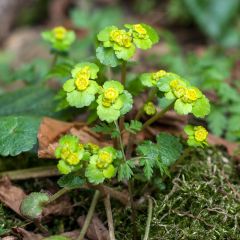
Chrysosplenium alternifolium
- Flowering time May to July
- Height at maturity 15 cm
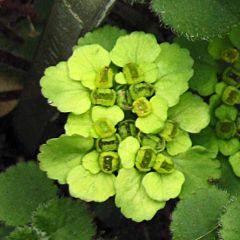
Chrysosplenium davidianum
- Flowering time May to July
- Height at maturity 10 cm
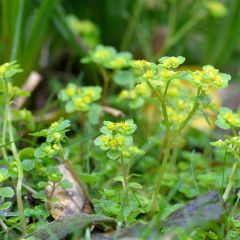
Chrysosplenium oppositifolium
- Flowering time February
- Height at maturity 10 cm
Discover other Chrysosplenium
View all →Available in 1 sizes
Available in 1 sizes
Available in 1 sizes
Available in 1 sizes
Available in 1 sizes
Planting Chrysosplenium
Where to Plant It?
The golden saxifrages are very hardy perennial plants that can withstand temperatures as low as -25°C. They are easy to grow in most of our regions. However, their cultivation will be impossible in a Mediterranean climate, which is too dry and hot in summer, as they require soil that remains consistently moist. They thrive effortlessly in heavy, clayey, moist, humus-rich soil. They love moisture and dislike full sun, preferring deep shade instead. Plant them in a partially shaded and cool spot during summer. They can tolerate dappled sunlight if moisture is not lacking.
The clumps expand over time but remain easy to control. Golden saxifrages make excellent evergreen ground covers near a pond, under tree cover in a damp woodland, by a stream, among rocks near a waterfall, or in a cool rock garden. This plant will also be content with soil that never dries out, making it suitable for planting along pathways or in shaded borders, for example.
When to Plant Chrysosplenium?
Chrysosplenium is best planted in spring, from February to April, avoiding periods of frost and drought.
How to Plant It?
Plan for approximately 7 young plants per square metre to create a dense carpet.
- Dig a hole 2 to 3 times the size of the root ball
- Plant in a mixture of garden soil and humus-bearing compost
- Fill in and lightly firm the soil
- Water thoroughly and then very regularly
⇒ Discover the right techniques for planting a perennial in our video!
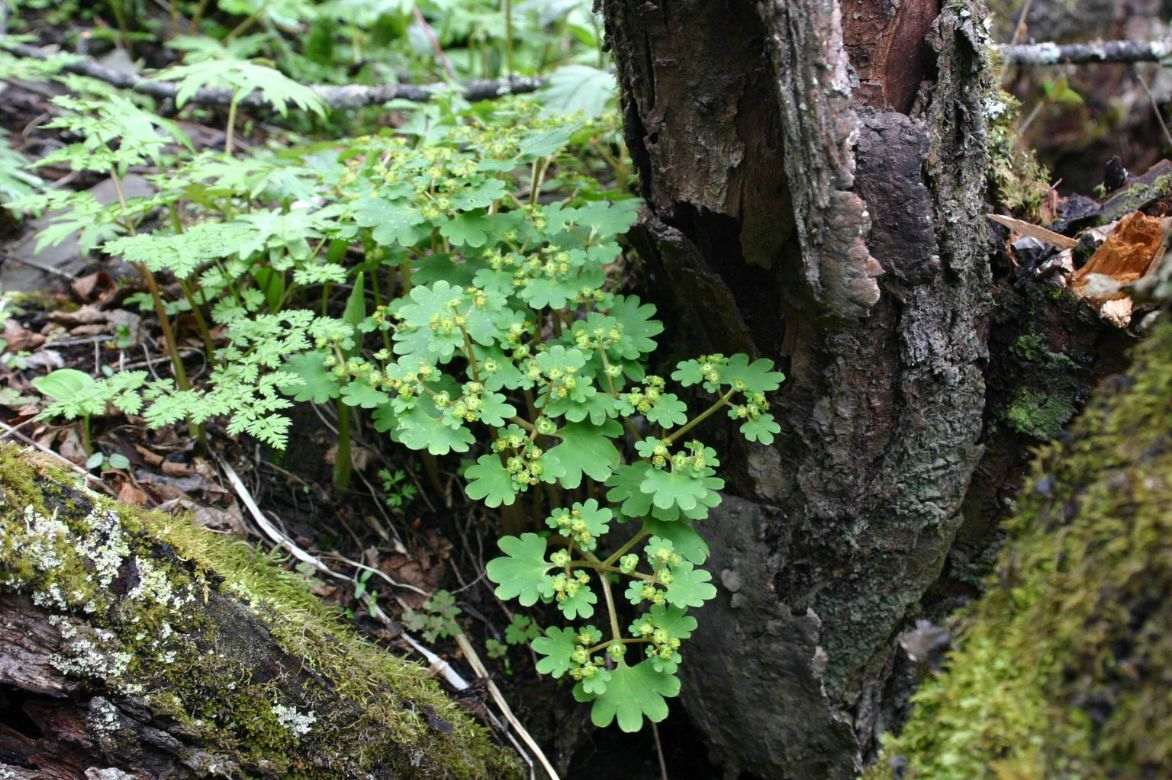
Much rarer: Chrysosplenium griffithii
Growing and care
The golden saxifrage requires little maintenance as long as it remains in consistently moist soil throughout the year. It is a trouble-free perennial once established. It does not tolerate dry soil. Ensure the soil remains moist, especially in summer, or this perennial may wither. Water regularly during the first summer and then 1 to 2 times a week to keep the soil constantly damp.
To control its spread, you can remove excess runners.
Propagating
To ensure the longevity of the Chrysosplenium, simply detach the rooted stolons at the end of summer. Take the rooted stems and replant them in the chosen location in moist soil.
Associating
With its evergreen foliage of bright green and its spring flowering, the Dorine is a highly useful ground cover to bring a luminous touch to shaded areas. This plant is perfect for dressing the banks of a water feature. It forms a dense, low carpet of beautiful green, adorned with delicate little yellow or white flowers, depending on the variety.
It can be paired with other creeping plants such as Houttuynia cordata, creeping bugles, or Asarum, as well as spring bulbs like snowdrops and Fritillaria meleagris, which will emerge from this green carpet.
At the edge of a partially shaded bed, it will welcome the delicate flowering of Fairy Wings, dodecatheons, and Mertensia virginica, a lovely spring plant.
In a water garden, it will fill out the base of beautiful perennial marginal aquatic plants such as pink astilbes, lady’s mantles, and other cool shade perennials like ferns and hostas.

An example of an association: Asarum maximum ‘Ling Ling’, Chrysosplenium alternifolium, Heuchera ‘Obsidian’, Fritillaria meleagris, and Epimedium perralchicum ‘Frohnleiten’
Useful resources
- Discover our collection of perennial plants for moist to wet soils
- Get inspired by our selection of aquatic plants to enhance your water feature!
- Subscribe!
- Contents































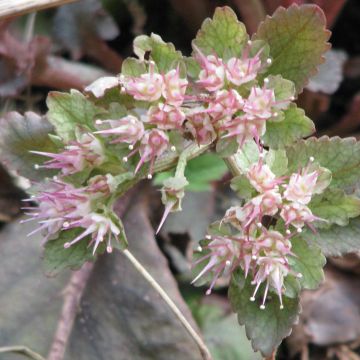



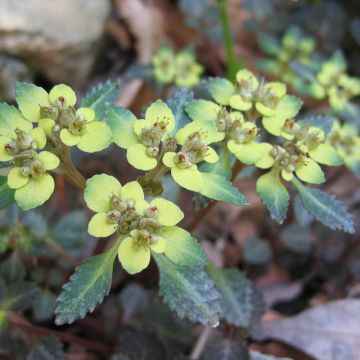
Comments